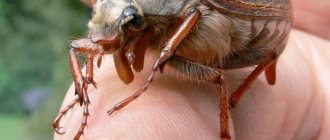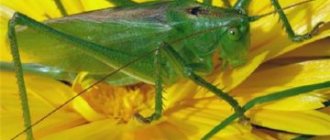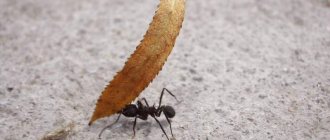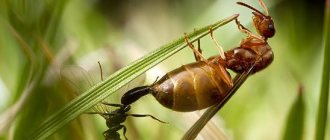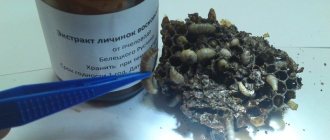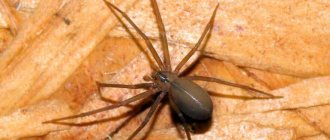Ant: what is a forest insect?
The image of an ant in the human mind has been fixed since childhood: a head, a belly and a butt, connected to each other by flexible ligaments. The entire body of the insect is covered with a thick chitinous layer .
In ants it is one of the most durable in nature. Some tropical species can withstand the bite of a spider (also tropical). Our forest dwellers cannot boast of such strength, but in battles with their relatives the shell saves them, and not bad.
How many legs does an ant have?
The picture is completed by six flexible legs . They are very strong, but the loss of the hind pair of legs will not allow the insect to move fully; the loss of the front ones can completely immobilize the insect.
Functions of the legs
As mentioned earlier, any ant has six legs, which in turn perform various functions and are equipped with spurs.
Due to their special structure, ant paws have certain abilities that these insects use not only for movement, but also during battles with other insects. Also, thanks to their special limbs, ants move perfectly on completely different planes, and there are practically no obstacles for them.
Ants can calmly move not only on various surfaces, but also perform various maneuvers, as well as cling to any objects. It is as a result of the presence of such limbs that many ants can swim quite well. This is especially true for bulldog ants, since these insects are considered one of the most unique.
Ants can calmly move on various surfaces and make the necessary maneuvers
Among other things, it is thanks to their eight limbs that ants can perform completely different jobs. The legs of this insect are very strong and the fact that the ant carries objects quite heavy for its weight can be explained from the physiological point of view. This is explained, first of all, by the fact that the cross-section of muscles with a decrease in body size is measured proportionally. That is why these very small insects are able to carry objects that weigh much more than the insect itself.
Note! Due to the fact that the ant’s limbs are quite developed, these insects can not only defend themselves, but also swim across puddles and also jump.
As evidenced by long-term observations of ants, these insects, thanks to their legs, can perform many different jobs, which include carrying food, as well as objects that, in their weight category, significantly exceed the insect’s own weight.
The ant's limbs are also necessary for it as navigational material. This is reflected primarily in the fact that the ant perfectly remembers the number of steps that the insect has taken after a particular turn. This memorization of nuances helps the ant always flawlessly find the way back to its home.
The speed of an ant is in its limbs
An ant has three pairs of legs, so it is not difficult to count how many legs it has. Another feature of the limbs is that all pairs have certain sizes, proportions, and also that they are all located on separate parts of the chest.
As for the front pair of legs, they are located on the front of the chest and are distinguished by special devices, which in appearance are more reminiscent of miniature brushes with which the insect cleans its other legs, as well as its mustache. The rear pair is equipped with spurs, which, as in the first case, perform their specific functions.
One characteristic of ants' feet is that they have an odor.
Thanks to the small notches that are present on the paws of ants, they can not only easily climb various surfaces, clinging to ledges, but also develop quite good speed. Some varieties of these insects are capable of speeds of about four km/hour.
I would also like to note that ants swim quite well, especially for varieties such as bulldogs. These insects are able to swim across a body of water up to fifteen meters away.
Another feature of ants' feet is that they have a smell. This has been discovered through numerous scientific studies. This phenomenon is explained by the fact that the limbs of these insects secrete pheromones, which are used to leave peculiar marks during movement.
How much does an ant weigh
The black forest ants familiar to us cannot boast of a large body mass. They reach a maximum of 10 milligrams, and on average weigh 6-8 mg . Moreover, the age of the insect does not matter much - after pupation the insect stops growing (there are exceptions).
How much it eats doesn’t matter either. By the way, the sense of smell helps ants get food . In some species it is more powerful than in dogs. The vision is a little let down - the insect has a lot of eyes , but they don’t give a clear picture.
The world is blurry for forest dwellers.
Functions of the feet
The hind legs are equipped with spurs that perform various functions. Typically, ants often use them in battles with their brothers . Their paws have a special structure, which gives them special abilities. For example, for ants there are no obstacles in the form of a plane that are inaccessible. Small and nimble creatures can move along a smooth and vertical plane. The smaller the individual, the easier it is for it to move on any plane. Domestic creatures can easily run on a glass surface, but for example, cockroaches cannot do this.
And how many different maneuvers ants can perform on different surfaces thanks to tiny notches on their legs. The serrations help them grab onto almost any object. Various protrusions in the form of stones or bark serve as convenient stairs for them in natural conditions.
Thanks to their paws, some species of individuals can swim well . These include Australian bulldog ants. These insects are considered unique due to their rare qualities. They can swim across small puddles at a distance of 15 cm. Insects can also easily jump long distances up to half a meter in length. True, it is not their legs that help them in this, but their jaws, with which they push off the surface of the earth.
With their six legs, hard workers perform many jobs. They have the peculiarity of spreading their limbs wider than their body, due to which insects manage to carry objects several tens of times heavier than their own weight. This can be a load 50 times heavier than the weight of an ant.
The legs also serve as navigational material for ants. The insect remembers how many steps it took after a certain turn. On the way back, it makes an adjustment precisely to the given angle and the remembered number of steps.
There are weaver ants that use their legs to build a nest. With the help of their paws, workers collect leaves and build nests from them. In this case, several dozen individuals can be taken. They grab the leaf with their jaws on one side and their paws on the other. The fastening material is the secretion secreted by the larvae. Thus, working individuals build housing for a large family; it is suspended, but very convenient for a whole colony of ants to live in. One can only imagine how many such nests the little hard workers managed to build.
Why does an ant have 468 legs and the characteristics of these insects
Of course, the statement that an ant has 468 legs is completely unfounded. All varieties of ants have a constant number of limbs, which is six pieces, divided into pairs.
Ants are considered unique insects and, compared to other arthropods, have the following features:
- The sizes of these insects vary from one millimeter to five centimeters. Females are larger in size and also have wings, which they chew off after the mating season. The color of these insects can be completely different.
- Ants do not have clear vision, but they can clearly distinguish movement.
- The antennae of ants have a segmental structure and perform the functions of organs of touch. It is through them that insects sense air currents, smells and vibration.
- It is by smell that ants find food, send signals for help and make various requests.
- In nature, ants use mandibles, which are very powerful, and acid for protection.
For the most part, ants are considered not dangerous insects for humans, but still in nature there are varieties that can not only have a negative impact on human health, but also cause death. Therefore, it is very important to know about such individuals, especially for those people who travel around the country and the world.
Types of ants
Each ant colony has different castes of ants, each with a specific role.
The most common caste type in any ant colony will be the worker caste. As the name suggests, the worker's primary role is to care for the queen and brood, forage for food, build and protect the nest, and other labor-intensive tasks. Worker ants do not reproduce, although they sometimes lay eggs. They are unsterilized, so they are only available to develop into drones, which are of no use to the colony, so eggs laid by workers are usually used as brood food.
The soldier caste is not present in all ant species, and they tend to have an extended worker form. Soldiers tend to be tougher than standard workers and have large heads with strong mandibles. The main job of a soldier is to protect the nest, but they can perform other tasks as well.
The most common caste type in any ant colony will be the worker caste
Male ants, also known as drones, are often smaller than all other castes, although this is not true of all species. These ants have a wasp-like appearance, and have small heads and thin bodies compared to other ants. All males have wings and their sole purpose in life is to impregnate the virgin queen during the mating flight. Once they have completed this task, they will die within a few days. Eggs left infertile by the queen produce males.
What else do ants need paws for?
Ants need legs not only as a working tool, but also for movement. Individuals use their paws to transmit scent signals . On ant limbs there are glands that secrete pheromones with a strong aroma. While moving, insects leave marks using glands on various objects. Other individuals will immediately notice such a trail and will be able to easily detect it. A large number of ants, running along such paths, leave many traces, they become attractive to other ants. Over time, the trails turn into comfortable routes along which insects run comfortably and quickly. Sometimes ants make mistakes and can run in circles because leaving a fresh mark closes the circle. As a result , the insect runs in a circle and very often it happens that the number of ants running in a circle reaches several hundred. In everyday life, such circles can become a real disaster for a family.
Many people have long known how many legs an ant has. These small and multifunctional limbs help ants work and create real miracles with their help.
Glands on the legs as a tool for orientation
Ants also use their legs to transmit scent signals. Scientists have discovered glands on the legs of ants that secrete strong-smelling pheromones. Ants leave these substances as marks on various objects as they move, making the path more visible to other individuals.
The more ants run along such a path, the more marks remain on it, the more attractive it is to other individuals. Accordingly, the most visited paths look like comfortable highways to ants, while the newly marked routes are comparable to a barely traveled path in the forest.
It is because of errors in the placement of such marks that the famous ant circles occur: if an ant accidentally runs in a circle and closes its own path with a more recent trail, obeying instinct, it then continues to run in a circle. Several of his brothers can connect to it, and when the number of ants exceeds several hundred, such a circle can become a real disaster for the family - the ants can run around in it until they are completely exhausted. However, such a circle can only arise in the absence of noticeable external landmarks, when the ants are forced to use only their scent trails for navigation.
Therefore, the next time you see an ant, take a closer look at its legs. These thin and inconspicuous organs at first glance help little hard workers work real miracles!
Industrious ants are found everywhere and often live in our homes. When they move into a residential area, this becomes a real problem. Their appearance in the apartment is a mystery to most of us. They always move quickly, being constantly busy and busy. What is the structure of an insect, how many legs do ants have, and what role do they perform?
Ants belong to the family of insects, the order Hymenoptera, subfamily Antidae. This order includes their close relatives - bees and wasps
. In their structure they are all very similar, including the presence of wings. The only exceptions are certain ones. In total, there are 12,000 species of these insects on our planet.
The body of an adult is divided into three main sections:
- voluminous abdomen;
- large head;
- small breasts.
Insects are divided into 3 castes - females, males and workers.
. Females and males have differences in structure and they have wings. Working individuals do not have wings. The first ants, which still existed during the era of dinosaurs, had a primitive structure. Very often you hear the question, how many legs does an ant have and what is their speed? The answer is very simple - only 6 legs or three pairs of legs. They can be easily counted in adults; in adulthood, the limbs are clearly visible and distinguishable.
Reasons for the appearance of ants in the apartment
Differences in appearance differ depending on the species as there are differences in the size and weight of the insect's body. For example, representatives of the tropics reach only 2 mm in length and weigh no more than 2 mg. There are also large species, the weight of which can reach 90 grams, and their body length reaches 3 cm. Despite the difference in weight and size, their structure is very similar.
How long does he live?
The lifespan of ants in nature is determined, first of all, by species. How long an ant lives depends on what species the individual belongs to
.
Eg:
- Pharaoh ants. Insects belonging to this species are heat-loving and adapted to living only in human housing. The lifespan of queens of this species is nine months, workers - no more than two.
- Garden black ants. These insects prefer to settle in close proximity to human habitation, often in private homes. The lifespan of representatives of this species is three years, but in fact - no more than one year.
- Forest and meadow. These ants, as the name suggests, live in forests and meadows. Life expectancy is no more than five years, but due to natural factors such as predators and birds, the given periods can be significantly reduced. The life span of queens is longer than that of ants of other castes, since they are protected from external enemies.
- Tropical ants. These insects are called the longest-livers among all species. The queens of this group live more than twenty years, while the workers live about five to seven.
The lifespan of ants is directly determined by the action of external factors, which include enemies, predators, birds, as well as diseases and natural disasters.
What does it look like
The appearance of individual ants depends on the caste and species.
For example, this is what representatives of some groups look like:
- Pharaonic. The length of the body of a representative of the working caste is no more than two millimeters, the color of the abdomen varies depending on age and can be reddish, brown or yellow. Females and males are distinguished by their larger sizes - about four millimeters and black body color.
- Red forest ones. Today, the number of this group has decreased significantly, which is due to a reduction in forest resources. Red forest ants are relatively large in size, ten to twelve millimeters. They are characterized by a red color on the abdomen and black on the chest.
- Black. Distributed throughout the country, they are classified as agricultural pests, which is due to the specific nature of their habitat and life activity. The body size is five millimeters, the body color is brown or black.
- Myrmica red. The habitat covers the territories of Siberia and the Urals. Ants of this group settle near agricultural lands, which is due to the characteristic features of their life activity - they consider insect pests, for example, aphids, as food sources. Body length varies from five to seven millimeters. Color depends on gender, females are red, males are black.
- Blood red. This group of arthropods is reddish in color and medium in size - about eight to ten millimeters in length. A distinctive feature is the specificity of life activity. Anthills raid the anthills of other colonies, capturing larvae and eggs. Further, the individuals obtained in this way are used as workers - slaves.
The external features of arthropods also depend on caste . For example, guards or predators have powerful jaws, with which the ant defends its own home or raids representatives of other colonies.
Workers are small in size and have a short life expectancy. The uteri are extremely large in size, significantly exceeding the size of representatives of other castes. The life expectancy of female queens is also much longer than that of their relatives.
Difference between an ant and a spider
Ants are considered one of the most common insects. Their breeding into an independent family happened quite a long time ago. Information about the first individuals can be traced back to the time of dinosaurs.
The main characteristics of an ant as an insect are the following:
- colonial social way of life;
- presence of caste;
- metapleural gland;
- reduced veins on wings;
- a narrow stalk connecting the chest with the abdomen;
- upper jaws, which have a serrated chewing edge;
- absence of individual cells in larvae.
Almost all varieties of ants prefer to live in anthill nests, which they dig themselves in completely different places, such as the ground, under stones, in tree trunks, and also equip them directly in human housing.
Ants are considered one of the most common insects
The average lifespan of this insect is about four years, but the exact period depends entirely on many factors. There are cases when situations were observed. That ants can live for about six years.
The structure of the first ants was very primitive compared to those insects that can be found today. The main difference between ants and other arthropods is that an ant has only six legs, while for example, a spider has eight. Therefore, spiders, although they belong to arthropods, are classified into a separate family called arachnids.
Everyone, even schoolchildren, should know such basic differences in insects. Unfortunately, at the moment, although schoolchildren see ants every day, not all of them are ready to answer the question of how many legs certain insects have. For example, such an elementary and well-known problem that ants and spiders have 468 legs very often remains unsolved and is vigorously discussed by users on the Internet of various ages.
The answer to the question from the scientific side
Scientific facts will help you accurately answer the question of how many legs an ant has. The represented species of individuals is a large class, the name of which is insects. Their main exclusive feature is the presence of 6 legs, the same applies to ants - they also have 3 standard pairs of legs.
It is worth taking into account that it is the number of limbs of fauna representatives that distinguishes arthropods from ticks and spiders. A tick has 8 legs, and a spider has 16.
Let's look at another question - is it possible that an ant will have fewer legs? According to scientists, they cannot give a negative answer, since in fact this option is quite real.
This can be explained by the fact that such pests have a predatory lifestyle and often enter into a fight with other types of insects, in which there is a risk of losing their running legs. Only such cases can cause the absence of pairs of paws in an arthropod.
Does an ant have blood?
No, insects, of course, have a semblance of blood, but if you crush it, you won’t see anything red. Hemolymph flows through their bodies - a transparent liquid that provides nutrition to vital systems.
The loss of the “life-giving” substance leads to the death of the insect, but given its viscosity, a strong outflow is hardly possible; for this, the body must be severely damaged, actually tearing it apart.
Ant colonies are separate worlds . It’s not for nothing that we compared them to aliens at the beginning of the article. These amazing insects have their own laws of sociality , which are incomprehensible and alien to human society. However, insects have been living according to them for millions of years, and they are happy with everything. Maybe they actually came to us from distant planets, and are now watching us, waiting for their finest hour?
What are the distinctive features of the structure of an ant's legs?
For a more detailed look at the body structure of small hardworking strongmen, you can look at the photos and diagrams below; if you wish, this can be done in reality by anyone.
If we talk about the most common forest and garden species of ants in our country, they are of sufficient size so that the structure of the legs can be examined without the use of special magnifying devices.
An interesting fact is that the legs of this pest are very strong, so much so that they are capable of carrying a load that will exceed the weight of their own body by 2 dozen times.
Each of the three pairs of ant legs is attached to the middle part of the body - the presented segment is scientifically called a mesosome. The first pair of legs (the legs are distinguished by the presence of very small and thin outgrowths) of the arthropod are located near the front of the chest, they are directed forward, thanks to them the insect takes care of itself - it puts itself in order, cleans the antennae (they, by the way, are part of the body , which helps them catch the smell of food and enemies).
The remaining pairs of legs are attached to the lower part of the chest, but their direction is already backward, downward. The main purpose of these legs is accelerated movement, support, in addition, they act as a means used in the fight against enemies.
Some types of ants differ in the structure of their paws, allowing them to jump to fairly high heights and swim.
Arthropods achieve maximum crawling speed on various surfaces due to the presence of serrations on each of the legs. With their help, pests can quickly and easily overcome almost any material that has at least minimal roughness on the surface.
The only exceptions for small workers are vertical smooth surfaces, for example, glass. By the way, many owners of apartments, summer cottages and country houses use this feature as an effective technique to combat these arthropods.
Nutrition, reproduction
Most often, nests are built in the soil, but they can also be seen in wood or under stones. Ants feed mainly on plant sap or the honeydew of sucking insects. Some species eat seeds and mushrooms. The basis of the diet is proteins and carbohydrates. Protein is consumed by larvae, and carbohydrates by adult insects.
These are universal predators. They hunt invertebrate insects or gnaw their corpses. Any food in the anthill is distributed among all members of the family.
Young individuals go through the following stages of development:
- egg;
- larva;
- chrysalis;
- imago is an adult insect.
A worm-like, sedentary larva hatches from the egg, and workers begin to care for it. With the onset of the pupation phase, the larva stops feeding, but while it is still eating food, it can develop into a queen or worker. Nutrition determines everything.
In the larval and pupal stages, ants live in a separate place where a constant temperature is maintained.
Working individuals help the imago free itself from the pupa, since the young individual is not able to leave it on its own.
Pedipalps and antennae
In addition to walking limbs, spiders have clearly visible pedipalps; they are located in front of the front pair of legs. Sometimes they look almost like another pair of legs, and are even capable of participating in locomotion, but are more used as part of the oral apparatus, helping in the capture and placement of food in the mouth.
But even if you mistakenly count the pedipalps as an additional pair of legs, then based on the total number of legs, the arachnid still cannot be confused with an insect. But by looking at an ant, you can inadvertently attribute the antennae that are on its head to its limbs, and mistake the insect for a tick or spider.
The antennae of ants have a special structure - they are geniculate, seemingly bent in the middle, with the tips pointing downwards. The antennae are located next to the eyes, are much thinner than the legs and are very mobile. They perform the function of tactile, tactile organs, serve for orientation in space, perception of smells and exchange of information with other ants.
If you encounter any insects or arachnids at home or in nature, you should be careful. Especially if species identification is difficult in some way. If any of these creatures are found on the body or clothing, it must be carefully brushed off or blown off without pressing with your hands or slamming it on the skin.
The speed of an ant is in its paws
It has 3 pairs of legs, so there are 6 legs in total, this is the main difference between an insect and a spider. All pairs of paws have their own sizes and proportions and are located on a separate part of the chest. The front legs are on the front of the chest. These paws have special devices that resemble miniature brushes. With their help, the insect cleans its whiskers and other legs.
The hind legs are equipped with spurs that perform specific functions. Most often, spurs serve as weapons of defense or attack. Insects use them to fight other ants. Due to the unique structure of their legs, ants can perform many useful and vital actions with their help.
Very often, insects are forced to move along a smooth and steep surface . Due to the structure of their paws, this is not an obstacle for them. Very small ants can move on any surface, such as glass, which cannot be said about spiders or cockroaches.
The small serrations on their paws help them overcome many obstacles along the way. With their help, ants cling to protrusions on the surface. The bark of trees and stones are their natural habitat, so they move along them like stairs at high speed. Some species can move at speeds of up to 4 km/hour.
Where do ants spend the winter?
in winter
ants don't sleep
, as it may seem to some observers. Their activity remains all year round, although during the cold season they do not appear on the surface of the earth. Almost all of the ant’s labor activity is aimed at preparing for wintering.
Since spring
, they constantly replenish food supplies
. If this is not done, the colony will be doomed to extinction - in the conditions of fallen snow, these insects are not able to obtain food for themselves.
All stocks
are located in the lower chambers of the anthill
, there are ants there after the arrival of winter. The fact is that the deeper you go into the ground, the warmer the conditions will be, and sharp temperature fluctuations can be avoided. An ant's diet depends on its species.
Duration
wintering depends on the place of residence of the colony.
In the polar regions you have to stay underground for 7-8 months, and in the south 2-4. If we take it further south, for example, Turkey, then ants will not overwinter every season. It all depends on the severity of each particular winter.
If the ants don't do a good job
, then in winter the family may be overtaken by hunger
.
In such a situation, all insects will rush to save the queen
, giving her all the supplies. This is a kind of law of survivability in the wild.
Ant wintering
What do you think ants do in winter? Sleeping - many will answer. No, you're wrong. Their life continues to boil. A few species enter a state of diapause, when the internal organs of insects reduce their work, but do not completely stop it.
Many materials behave like a solid when it is stressed by forces moving at certain speeds, and a liquid when the stress slows down. Water, for example, behaves like a liquid when you insert your hand into it, but a solid when hit by a human body jumping off a dive board—the reason why your stomach hurts so much.
Researchers have discovered that the ants' structures are a combination of solid and liquid substances when they are amplified by forces at all speeds. They actively deform their structure to adapt to stress, but then return to their original position. Check out what happens when one of their structures is squeezed by a Petri dish, for example.
Ants spend the winter months in the same anthills in which they are active. And to prevent frosty air from penetrating inside, insects carefully seal the entrances with dry leaves. Sometimes they are lowered into the lower “compartment” of the nest, where a warmer temperature is maintained.
During wintering, ants are inactive and do not feed as often. But if there are larvae in the nest, then the adults remain fully active and feed the offspring. In addition, due to temperature fluctuations, the upper layers of the anthill periodically get wet and the ants are constantly forced to transfer food supplies to dry compartments.
“It makes sense based on their natural environment,” Hu says. “If they're floating on a raft on a river, they can't control where it floats, so if there's something like that—let's say a branch—you see a reaction and flow around the branch, kind of like an amoeba.”
The tenacity and buoyancy of ants is also remarkable. When researchers tried to push floating rafts below the surface of the water, they found that they could resist significant forces and float back. This is, in particular, provided by the exoskeletons of ants, which are naturally hydrophobic. When many ants come together to form a structure, water does not penetrate into the spaces between them, so when they are forced underwater, the air that remains in these cavities helps them float.
The anthill seems dead in winter, but the same vibrant life boils there as in the warm season
On a note! Under harsh climatic conditions, for example, in northern regions, ants are able to tolerate especially low temperatures. Thus, the body temperature of -58°C was recorded in larvae wintering in Kolyma. This figure is the lowest for insects in general.
Perhaps the biggest mystery about these ants' remarkable living structures is how the creatures communicate to build them. Microscopic examination shows that the ants grasp each other using both their jaws and the small claws at the end of their legs.
Noting this, Hu adds: "We think they were communicating, but we don't understand it yet." The ant grabs the leg of a neighboring ant in its jaws. Ant fire is depressingly persistent. Colonies of aggressive, poisonous insects can survive floods, fires and pesticides. Now researchers have uncovered the mechanisms behind one of the world's most sophisticated survival techniques: rafts made of thousands of ants tied together that repel water and sometimes float for months at a time.
Some species of ants that do not have diapause are forced to remain active throughout the winter. To survive, they stock up on food during the autumn months, which should be enough until the thaw. At this time, the workforce is repairing the nest and trying to maintain the microclimate.
The larvae of these types of ants require protein food to grow, which is impossible to obtain in winter conditions. Before the arrival of cold weather, they develop to the state of adults and then go to winter. And with the onset of spring, when access to protein food opens, the queen begins to produce new offspring.
The results could eventually help engineers develop self-sealing lifeboats and new waterproof materials. Fire ants are native to South America, but they have invaded large parts of the American South. Ants swarm over other insects, worms and rodents. After a few hours, they can cut small animal bones down to the bone. If floodwaters inundate a colony, a common occurrence in the Brazilian rainforest where the insect is developing, individual ants attach themselves to their bodies to form a raft that carries them safely to new areas.
The difference between an ant and a spider and a tick
Spiders and mites belong to the class of arachnids, and ants belong to the class of insects. To distinguish them, it is enough to count the legs: all arachnids have 8 of them, that is, 4 pairs. Of course, the body shape of these animals also differs, but if they are small in size, it is not always possible to immediately see this.
Some pairs of legs in spiders differ in size and structure from other walking limbs. This is explained by their way of life: when hunting, spiders often use the limbs of the first and second pairs to capture prey and palpate the surface, and with their hind legs they hold onto a support (web, ground). But, despite external differences, the total number of legs is always constant in any species of spider.
In some ticks, the legs of the first pair are longer than the others, and the legs of the second pair, on the contrary, are shorter than all the others. And since the forelimbs are close to the head, they can be mistaken for antennae. With these legs, a blood-sucking tick clings to the body of a potential victim.
If there are doubts about the identification of an individual, then it is necessary to pay attention to the structure of the body - the segments of the ant and the spider are clearly visible, and the mite is almost drop-shaped, its head is small, and its body is wide, flattened, fused. Having drunk blood, the tick enlarges several times and becomes barrel-shaped.
The situation is much more complicated with the larvae of some types of ticks, since they, unlike adults (adult ticks), can have only 6, rather than 8, legs. At the same time, they also feed on the blood of animals and humans, and just like adult ticks, they are capable of infecting many dangerous diseases through their bite. But the body structure of larvae and adult ticks is very similar, and this is what you need to pay attention to.
Another distinctive and striking sign of ticks is slowness. Thanks to their comfortable legs, ants are able to run very quickly, spiders are also good runners, but ticks move slowly, crawling only a few centimeters per minute.
Features
People who have little understanding of biology confuse ants with spiders or mites. Insects can be distinguished by the number of legs: ticks have eight. The only arthropods in our fauna are ants, spiders and mites. However, some beetles are able to imitate the shape of an ant's body in order to penetrate the anthill. They are difficult to distinguish.
Ants use their legs for more than just locomotion. Since they are able to place them wider than their body, and also due to the strength of their legs, the insect lifts and carries enormous weight. The mass of such a load can be 50 times greater than the mass of the insect itself.
The ant also uses its legs to measure distances. This is done by insects that live in deserts. That is, legs are also a navigation tool. That's how many functions there are. The insect remembers how many steps there are before the turn and, focusing on the angle, makes an amendment.
The legs secrete strong pheromones - substances that produce marks when moving . This is how the insect shows its brothers the way. More marks attract more other ants. Sometimes mistakes occur when applying marks, which causes the insects following to lose their way and begin to run in circles. They close the trail with a fresher trail, and this can be a disaster for the whole family.
Thin, mobile and strong legs will allow the ant to work miracles and perform very difficult work every day.


